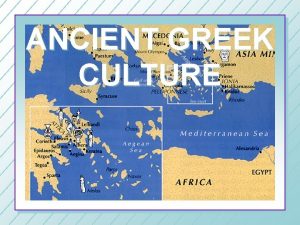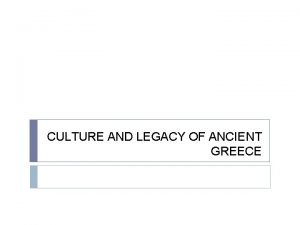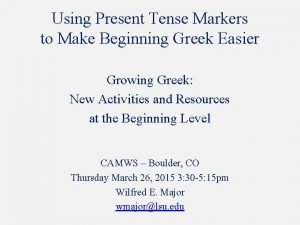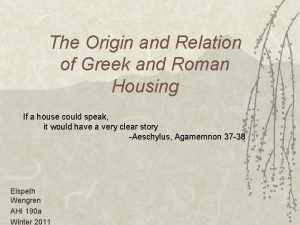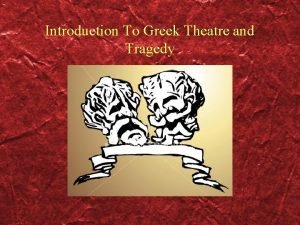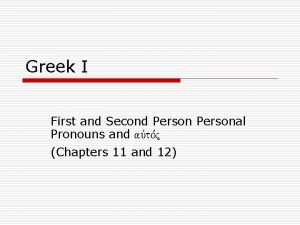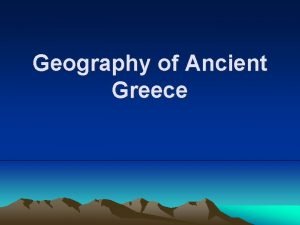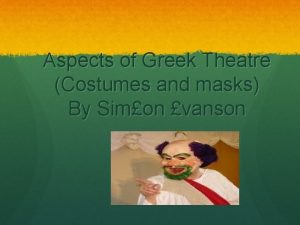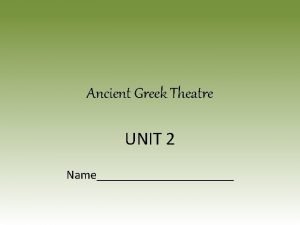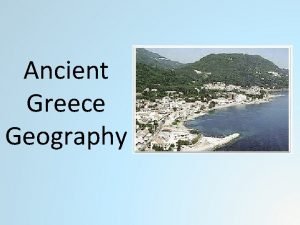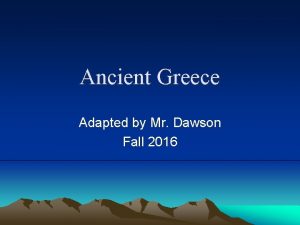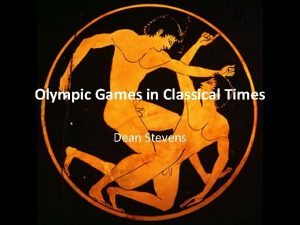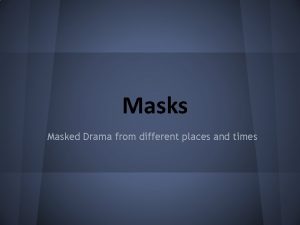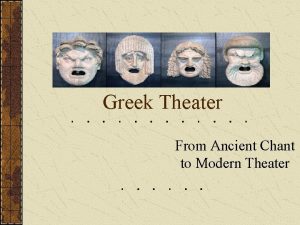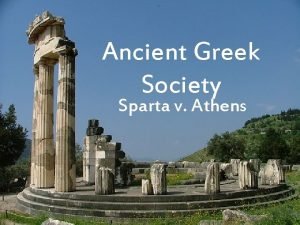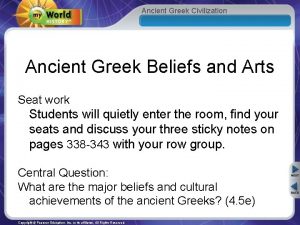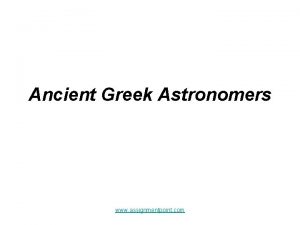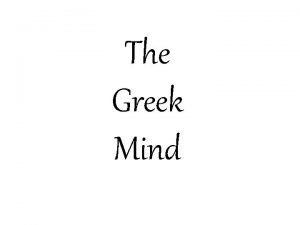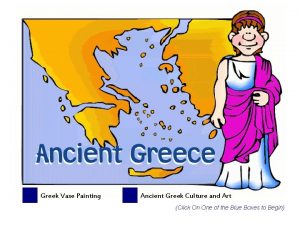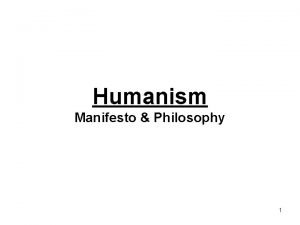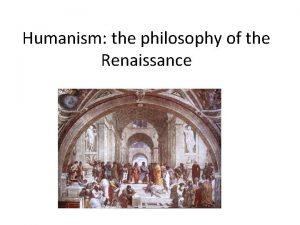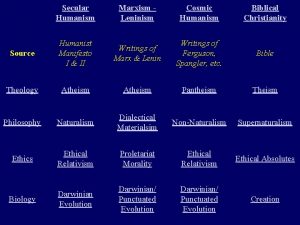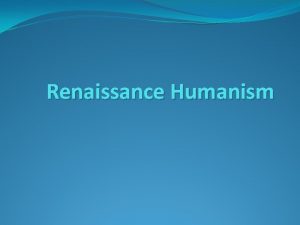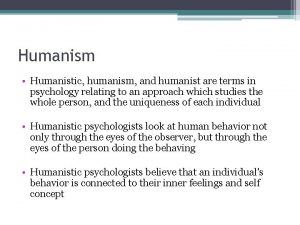ANCIENT GREEK CULTURE HUMANISM end for a while



























- Slides: 27

ANCIENT GREEK CULTURE

HUMANISM • end (for a while) of god-kings • “Man is the measure of all things” – Protagoras (p. 61 box) • plenty of gods but no sacred text or dogma • art reveals a delight in the human form

amphora ca. 530 B. C. ; Archaic Attributed to the Euphiletos Painter Greek Terracotta; H. 24 1/2 in. Black-figure technique Human figures as decoration (not in textbook)

Red-on-black SEE TEXT p. 46

Three periods • Archaic (650 -490 BC) • Classical (480 -323 BC) • Hellenistic (323 -145 BC) about 500 years in all

Archaic • epic and lyric poetry • evolution and change in works such as in terracotta from black figure to red figure • Pythagoras

Classical (480 -323 BC) • Plato, Aristotle • Theater – comedy & tragedy Sophocles (p. 59): Oedipus Rex, Antigone (play titles) about 150 years

Golden Age 480 -404 BC (or 480 -430 BC) Beginning of Classical Period 76 years! (or only 50) of demos (people) kratos (power) Democracy! (Also an Imperial era)

Hellenistic (323 -145 BC) • Works more dramatic • First to look back on “the good ol’ days” – Classical Greece • Alexander’s empire • Other philosophies: Skepticism, Epicureanism, Stoicism • doesn’t really end in 145 BC; continues while attention shifts to Rome, which invades Greece in 145 BC

Change in Greek sculpture An illustration of the 3 periods

kouros Kouros Text p. 47 monumental sculpture of human (6 ft. ) KEY IMAGE

What is a kouros? free-standing nude MALE youth. MALE = IDEAL sculpture would be outside a temple or serve as a grave-marker possibly a god, but usually a human athlete rigid symmetry from Egyptian roots "stylized geometry" note – the term is singular

kore Kore - female Text p. 47

The Archaic Smile Text p. 47

The first evidence of change in sculpture Kritios boy n No Archaic smile n New idea. . . n Contrapposto (weight shift; literally, “placed opposite”) n Idealized form - perfection

Kritios boy CLASSICAL TEXT p. 56 KEY IMAGE Ideal proportions?

Vitruvius: Principles of Symmetry (Roman, c. 30 BC) Probably based on writings of Polycleitus (Classical Greek) open hand = chin to top of hairline = 1/10 of entire body height head from chin to top = 1/8 middle of the breast to top of head = ¼ bottom of chin to nostrils = nose to eyebrow = 1/3 of face length of the foot = 1/6 of body height forearm = breadth of the breast = 1/4

Leonardo da Vinci, Proportional study of a man in the manner of Vitruvius TEXTBOOK p. 190

Poseidon/Zeus ? bronze dynamic pose!

Discobolus Text p. 57 Discus Thrower (Discobolus) by Myron

S-curve Hermes and Dionysis Text p. 55

Riace Warrior TEXT p. 56 -57

Laocoön and his two sons (lay ahk a wan) HELLENISTIC -- dramatic! - c. 150 BC KEY IMAGE p. 66

More Hellenistic examples p. 66 Copy after bronze original

More Hellenistic examples Copy after bronze original

More Hellenistic examples – Athena Slaying Giant, Pergamon, c, 180 BC p. 65

More Hellenistic examples p. 65
 Humanism in ancient greece
Humanism in ancient greece Ancient greece values
Ancient greece values Greek humanism
Greek humanism Perbedaan for while do while
Perbedaan for while do while Greenfoot reached end of file while parsing
Greenfoot reached end of file while parsing End while
End while Ancient communication devices
Ancient communication devices Ancient india vs ancient china
Ancient india vs ancient china What can we learn from studying ancient greek artwork
What can we learn from studying ancient greek artwork Indicative imperfect
Indicative imperfect Pastas greek house
Pastas greek house Egyptian floral art
Egyptian floral art Theatron greek theatre definition
Theatron greek theatre definition Greek floral design history
Greek floral design history Ancient greek actors wore
Ancient greek actors wore Auvto
Auvto Greece on a map
Greece on a map Ancient greek map
Ancient greek map Greek drama costumes
Greek drama costumes Greek theater labeled
Greek theater labeled Traditional greek musical instruments
Traditional greek musical instruments Orchestra greek theatre definition
Orchestra greek theatre definition Ancient greece map
Ancient greece map Climate in greece
Climate in greece Ancient greek olympics primary sources
Ancient greek olympics primary sources Ancient greek theater masks
Ancient greek theater masks Ancient greek masks
Ancient greek masks Ancient greek theater
Ancient greek theater
